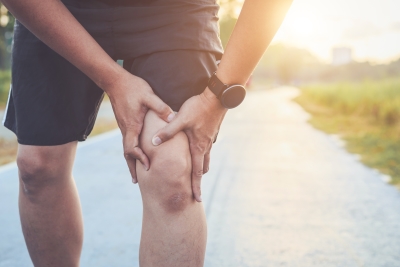
KNEE PAIN IS ONE OF those common complaints, like back pain, that affects just about everyone at some point in their lives. While it's true that some form of pain in the knee will befall most of us eventually, knowing the type of pain you're experiencing can go a long way toward getting the right treatment and finding relief. Some types of knee pain are harder than others to pinpoint, feeling "generalized" to the entire knee versus precisely located – so many of the conditions described below can cause the person experiencing them to feel pain all over the knee and not just in one spot. Although many knee pain conditions resolve on their own with minimal intervention and at-home treatments, not all of them do. It's essential to know what to watch out for if the pain you're experiencing warrants a trip to a doctor for proper evaluation and care.
Osteoarthritis, or OA, is among the most common causes of knee pain, especially in older adults. Though this type of pain can "radiate" to the entirety of the knee, the pain is often initially described as occurring on the inner side of the knee. OA is considered a degenerative disease – which means it breaks down the cartilage of the knee over time, resulting in a bone-on-bone grinding of the knee. Especially if the inner knee pain worsens over the course of the day with pressure from walking, climbing stairs or sitting in a chair, for example, these are clues that may indicate OA. If the above describes your knee pain experience, a visit to the doctor is essential. Though there is currently no cure for osteoarthritis, there are many treatment options that can help people maintain otherwise active and healthy lives while managing their OA symptoms. Other causes of inner knee pain may include rheumatoid arthritis, an MCL ligament tear or injury, a meniscus injury or bursitis.
When knee pain seems to be coming from the outer side of the knee, it could be a sign of an IT band injury or Iliotibial band syndrome – an issue that commonly occurs in people who do a lot of cycling or running. The IT band is a ligament that runs along the outer part of the thigh. When the IT band tightens or becomes otherwise irritated, it can rub against the thigh bone and cause pain between the hip and knee of the affected sign. This pain often worsens with increased activity. Treatment for IT band syndrome does require a medical diagnosis from a physician, but the good news is it usually resolves with proper physical therapy, and in some cases, steroid injections that can provide temporary relief while the inflamed band heals.
Beyond the pain being felt on the inner or outer sides of the knees, it can also seem to arise from the front or back of the knee. When knee pain is felt predominantly on the front of the knee, around the knee cap, this can be a sign of a condition known as runner's knee. Though the name would have you assuming that this is a condition experienced only by runners, the truth is that it's one that can be experienced by anyone and is commonly brought on by overuse, a fall or blow to the knee, foot problems or thigh muscle weakness. Medically referred to as patellofemoral pain syndrome, the associated pain with this condition is frequently felt on the front of the knee surrounding the knee cap and can worsen when you bend, squat, jump, run or kneel. The best treatments for this type of knee pain are rest, ice and wrapping the knee to create additional support, without constricting blood flow. NSAID medications can also help for a short time but always talk to your doctor first before starting these. Runner's knee often heals on its own without medical intervention but the time it takes is very much influenced by the individual who is experiencing the pain.
Jumper's knee is a condition characterized by pain that's frequently felt on the back of the knee, though it can become generalized to the entire knee. This condition commonly involves tendinopathy what is referred to as "functional stress overload" due to jumping. Jumper's knee often affects athletes and can occur in as many as 20% of the athletes who frequently engage in jumping (basketball players, for example). The condition is classified in four stages, and treatment is commonly based on the stage. Though jumper's knee requires a clinical diagnosis, treatment can include non-invasive options such as physical therapy and stretching exercises. In more severe cases or at later stages, steroid injections or surgery to repair the underlying issue may be necessary.
No matter where it hurts, knee pain can put a damper on active daily living. If you're suffering from knee pain that keeps you from living the life you want, it's essential to have a conversation about it with your doctor. Some lifestyle adjustments can make a world of difference for many people – strengthening exercises and weight loss for those who are overweight are among the options your doctor may ask you to consider. Our knees are critical to just about every human function required of us on a day-to-day basis, so giving them the TLC they deserve is crucial, whether or not they're causing you pain.
